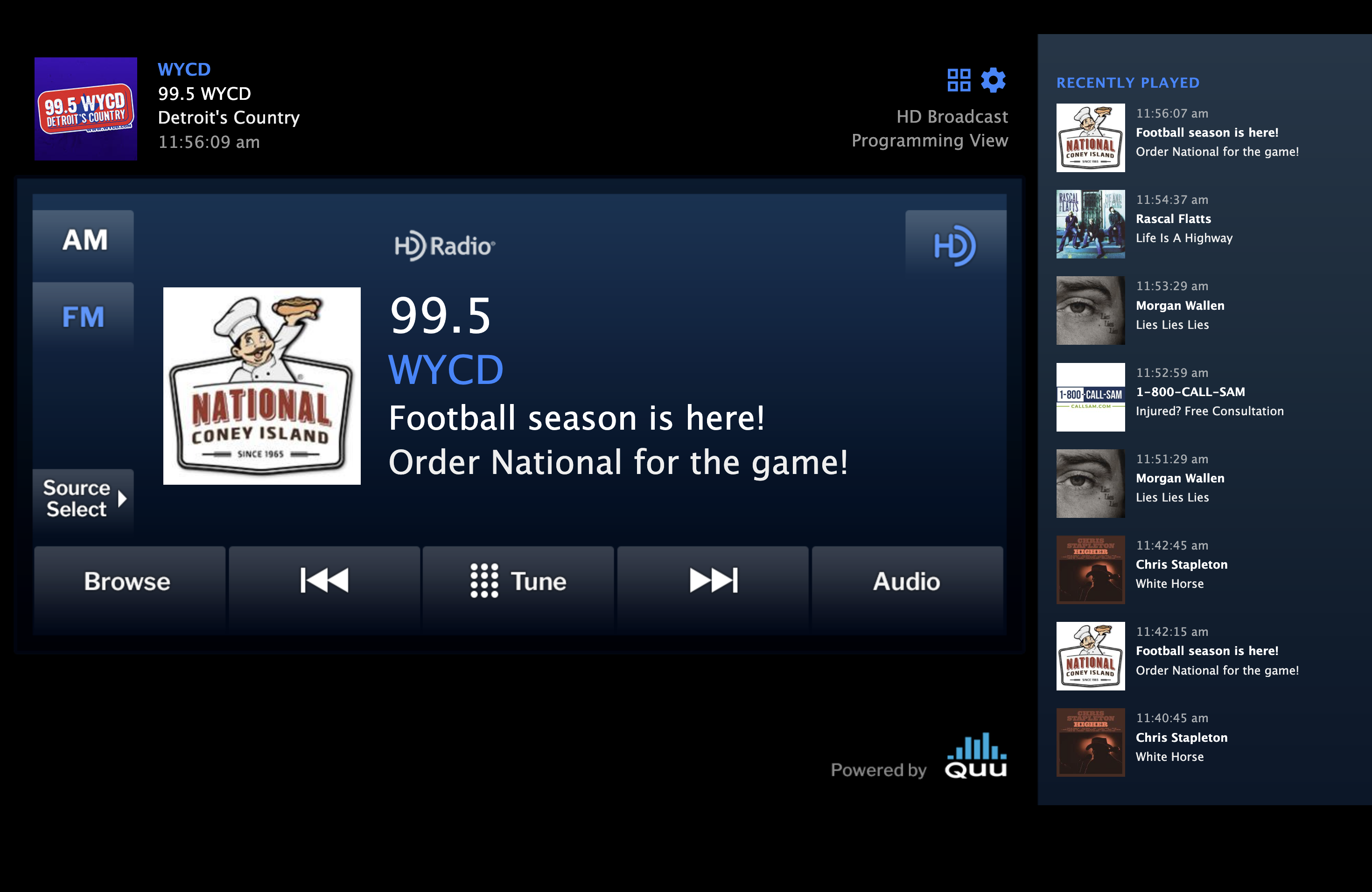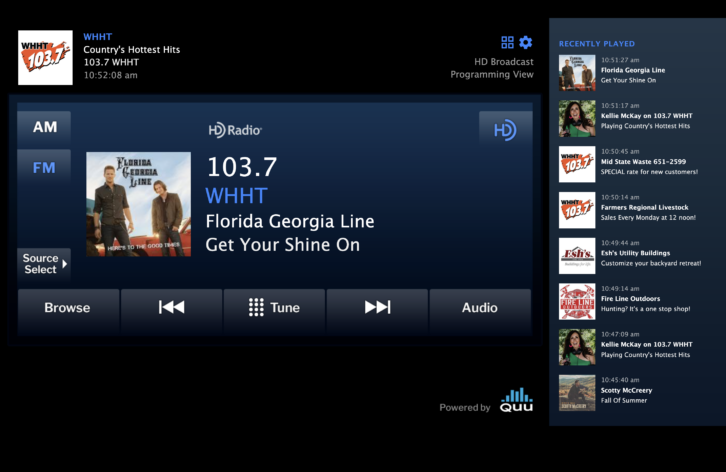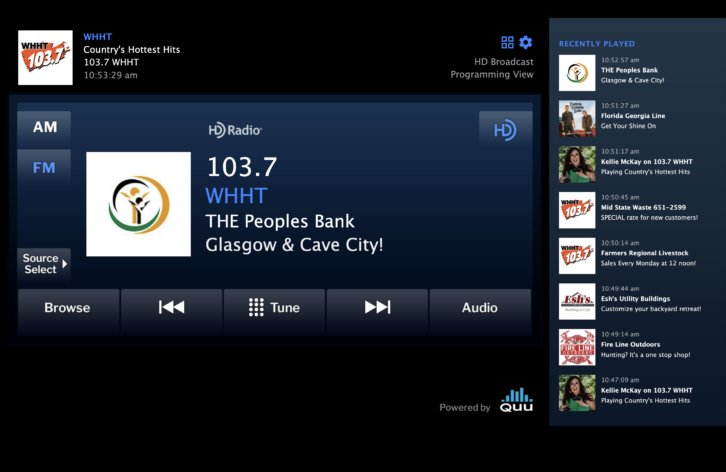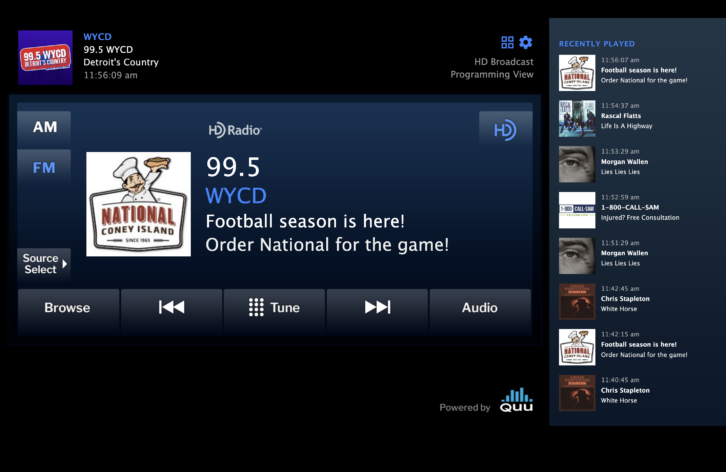World
Quu Refines Its Visual Message Offerings – Radio World

Quu provides software and services that allow stations to publish dynamic visual programming and sales messages on vehicle dashboards. Ad content can be synched to appear as a client’s audio ad plays.
Quu also now offers a Content Partnership program in which advertisers’ visual messages appear for 30 seconds while songs or other content plays, without interrupting that audio.
CEO Steve Newberry joined Quu in 2020. He is also a station owner, former chairman of the board of the National Association of Broadcasters and past president of the Kentucky Broadcasters Association.
This interview is from the free ebook “Recipes for Visual Display.”
Radio World: For someone not yet familiar with it, how does Quu fit into radio’s metadata ecosystem?
Steve Newberry: A station’s automation system generally provides metadata in a basic, manageable form — you put in the name of the song and artist, and perhaps the name of the commercial, and for many years that simply went to your RDS encoder, and its job was to convert that to display in the dashboard of the car.
Today RDS and the more advanced HD Radio platform are the delivery mechanisms. But what Quu does is add content management.
The content goes to the cloud, where we say, “Okay, this ad coming out of the automation system is for McDonald’s Mid Atlantic Co-op. The ISCI code for the co-op is 83-12-428.” But you don’t want that showing up on the dashboard of the car, so we give the station an easy way to replace that with the message “McDonald’s Big Macs are back, $1.99” or “Buy one, get one free sausage biscuit.” And we send that to your RDS encoder or HD system.
With our AdSync product, a station can add messages to a specific spot. So when they’re in a commercial break, if they’ve sold a commercial through AdSync, you would see a message pop up. But if a commercial is playing and the client didn’t buy the visual, Quu just shows the station brand.
But more than replacing the data, we’re allowing you to manage it. Which message plays when? Do you want a message about your morning show to appear for 30 seconds? Do you want it to rotate with a message about your studio sponsor? Rotate it with a message about news coming up, or with the station’s branding? Maybe you want to change it for middays instead of what you display in the mornings. Or you want to put up a tornado warning or a ball score for the big team.
One of our sports talk clients is the flagship station for Ohio State Buckeyes football. When the team announced the starting quarterback for this year, the station put that on the dashboard of the car. These tools give you the ability to provide a visual dimension to your audio relationship with the listeners.
I’ve said it before, but our industry doesn’t have a metadata problem; nobody wakes up every day saying “Oh my gosh, my metadata is terrible.” We have a listener experience challenge. Metadata provides a solution to that, but you have to manage it.

RW: What does the Quu display look like?
Newberry: Let me call up a monitor to show you one of my stations in Glasgow, Ky. (see first image).
We provide this back-channel confidence monitor view to clients. It’s the equivalent of a program feed at a radio station, so they can have a real-time view of what’s happening on their digital displays. At my own stations I put these screens up in our studios so the air talent can see it.
Now I want to tell you about our Content Partnership program. In the past, if stations sold a visual ad to an advertiser, because of a lack of ability to manage content they just ran it over the top of the entire commercial break. A listener would be hearing ads for McDonald’s, Lowe’s, Kohl’s and Newberry Chevrolet, but they’d see an ad for a law firm the entire time.
Jacobs Media did research on this and found that listeners thought the station had made a mistake, or they realized this was intentional but they hated it; they felt it was pushy.

I told you about AdSync and how it displays messages just during the client’s spot. But with the Content Partnership program, a station can sell two premium sponsorships that will display ads outside the commercial break, during songs or other content.
When a given song comes on, the screen first will show song information and album art for 90 seconds. Then a message from one of those two premium sponsors will display. In this example it’s TJ Regional Health and The People’s Bank. (See second image.)
The visual ad runs for 30 seconds and then goes away.
You’ve seen a station in Glasgow in Kentucky. Now here’s Audacy’s WYCD in Detroit, Michigan. The technology works great and just the same regardless of market size (third image).

During songs, after 90 seconds of song title and artist, the listener will see 30 seconds of an ad from one of their two content partners, which are National Coney Island and Sam Bernstein, Attorney at Law.
There are only two premium sponsors because we can’t inundate listeners. I don’t want your radio station looking like the outfield fence at a little league ballpark.
We’re also beta-testing a feature that will display “Next Up” information as the end of a song approaches. Programmers have asked for that.
RW: You provide verification that visual ads actually ran?
Newberry: We follow the cart number in the automation system. When cart number 8380 comes up, we display the message that the station wants displayed. Then when it’s time for them to go back and bill McDonald’s, they print out their usual affidavit showing the precise run times of their audio ads, and they can go to Quu and print out the display times for McDonald’s cart number 8380 and put those on top of each other. The station sends that to the client: “Here are your audio verifications, and here are your visual verifications, and they match up.”
RW: We hear a lot of names of platforms. How does Quu interact with those?
Newberry: Our content delivery management system is built on the foundation of the Rapid system from All In Media, a division of Xperi.
You’ll remember when we used to talk about “middleware,” which you needed to get a message from the output of the automation system to the input at the transmitter site — names like Arctic Palm, JumpGate and The Radio Experience. Arctic Palm became part of DTS eight years ago. Quu owns JumpGate. TRE is still around, owned by Broadcast Electronics. But we were really impressed with Rapid, and Xperi liked our content management system.
Joe D’Angelo of Xperi and I are very collaborative. We asked each other, “How can we make this process simpler for the radio broadcaster instead of getting everyone lost in an alphabet soup of all these different companies out there?”
In 2022 we rolled out an integrated solution to sync programming and sales messages on vehicle dashboards. Before that, stations would go to Xperi to deploy its Rapid technology and then to Quu for content management, monetization and reporting. Now, Quu is a one-stop shop for both. If you subscribe to Quu, it comes with the Rapid platform software. We help you get it installed, then we put Quu content management on top, and you get the best of both worlds.
We’re also easily integrated into the DTS AutoStage platform, since Rapid is a part of Xperi. DTS is a great platform, and Xperi doesn’t charge broadcasters for it. So if you’re a Quu customer on this Rapid platform, you’re getting an even more dynamic integration than what you get with DTS AutoStage by itself.
RW: But to be clear, a station doesn’t need one to use the other?
Newberry: A station doesn’t have to have Quu to take advantage of DTS AutoStage, nor do they have to have DTS AutoState to take advantage of Quu. But they sure work really well together.
With Quu, you put your information in once, and we send it automatically to whatever your distribution channels might be — your translator, your FM station, your HD signal, your DTS AutoStage, all through the Rapid software.
Think of DTS AutoStage as another delivery platform, building on AM, FM and HD Radio. Each of those provides more bandwidth and capability than the one before it. So if you’re managing for the connected car and getting the hybrid radio back-channel feed that DTS AutoStage gives you, it’s the state of the art.
RW: Is there a type of user who would use Rapid but not Quu?
Newberry: Predominantly non-commercial stations. Quu’s business model is helping stations look good and make money, which works well when you’re selling commercials, sponsoring dayparts and things of that nature. Noncommercial stations are not as commercially driven, for obvious reasons. The Quu platform has enabled people to start making some significant money.
RW: I suspect you’d say that a station should seek consistency across platforms, including its streams, in how it displays.
Newberry: The challenge with streaming is visual content usually is generated by the streaming provider, not the station. Triton takes the audio and says, “Oh, you’re playing ‘Small Town’ by John Mellencamp. We know what album art goes with that.” They put the image up and stations don’t have to worry about it. But now we’re working with streaming companies to figure out how stations can regain control of that editorial content and manage it in an integrated way.
RW: The NAB has done “radio audits” in a few markets and concluded that not enough broadcasters are yet paying attention to visual display, especially in small and medium-sized markets.
Newberry: Yet we’re a long way from where we used to be, and that’s reflected in our client base. Quu now is the provider for so many major radio groups including Cox, Hubbard, Salem, Urban One, Audacy and Beasley, which is one of our investors.
I think the industry is looking much, much better today. In some ways we just haven’t simplified the message for people enough. I believe there is a much higher awareness of the issue in markets of all sizes and I believe the industry is making really good progress — finally.
RW: Any other thoughts?
Newberry: When a station contacts us, we send an initial assessment that asks: “Do you have internet at the transmitter site? What automation system do you have? Are you currently displaying images? If you’re HD, are you sending text-only, or do you display images?”
Then we can make recommendations. We might say, “You can do this, but be aware that your current RDS encoder is static, not dynamic, so it’s just going to sit there and display your positioning statement.” I can charge someone $200 a month for our services, but if they also have to go buy a $4,000 piece of equipment, that’s a bigger problem. We don’t have a shoe that fits every foot; but we’re here to help. I want Quu to be a partner, a collaborator who helps you solve the problem.










